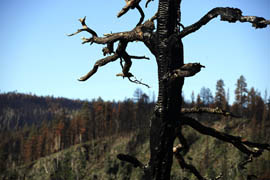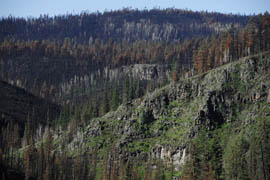Cronkite News has moved to a new home at cronkitenews.azpbs.org. Use this site to search archives from 2011 to May 2015. You can search the new site for current stories.
Plan to use conservation funds on damaged forests draws protests
PHOENIX – The Arizona State Parks Board and an environmental group are objecting to a state lawmaker’s plan that would tap a voter–approved fund intended for land conservation to help fund the restoration of forests devastated by wildfires.
Rep. Russ Jones, R–Yuma, said that while conserving land is important, the condition of forests and grazing areas is jeopardizing the economies of rural communities.
“We can’t afford one or more additional fires,” he said. “We are still in a time of great drought.”
HB 2336 would appropriate unused money from the Land Conservation Fund into a new Forest Restoration and Treatment Fund, operated by the state forester, to help forests damaged by fires.
The House Agriculture and Water Committee endorsed the bill Feb. 2 on a 7–1 vote, sending it to the Appropriations Committee.
Voters approved the Land Conservation Fund in 1998, requiring the Legislature to allocate $20 million a year to help municipalities match the costs of purchasing state trust land. Money from those sales primarily benefits public education.
In 2010, voters overwhelmingly rejected a ballot proposition that would have swept $123 million from the fund to help address the budget deficit.
Sandy Bahr, director of the Sierra Club’s Grand Canyon Chapter, said Jones’ bill violates the 1998 Voter Protection Act, a voter–approved constitutional amendment that bars the Legislature from killing ballot initiatives and requires a three–quarters majority in each house to change the terms.
“The Legislature has clearly not done its homework,” she said. “It’s bills like this that gave us the Voter Protection Act in the first place.”
Jay Ziemann, legislative liaison for Arizona State Parks, said taking money from the Land Conservation Fund would cut into the ability of cities and towns to preserve land.
“We’re all in favor of forest restoration,” Ziemann said. “But our concerns lie in the use of voter–approved funding for a purpose that was not approved by the voters.”
Jones said he went to the Legislature’s legal counsel before introducing the bill and was advised that unused and unexpended money isn’t covered by the Voter Protection Act.
The money appropriated would vary year to year, Jones said. Last year, there was about $90 million in unused funds and current unused funds are expected to be between $40 and $45 million, he said.
Jones said there isn’t time to have voters decide the issue. By November, he said, all the available funds will have been “scarfed up” by cities like Scottsdale and Phoenix.
“One of the problems with our system is that the Legislature is out of the loop,” Jones said. “We can’t take corrective action even if priorities change in the state. You voted 10 years ago, but now we have these other needs.”
After a summer in which nearly 900,000 acres burned across Arizona, GOP lawmakers are addressing what they call the federal government’s inadequate response to restoring and treating the six national forests here.
Sen. Sylvia Allen, R–Snowflake, authored a resolution that would inform federal agencies that Arizona is declaring an emergency and its sovereignty over forests.
Jones said Arizona has a responsibility to rural communities to step in.
“If it’s federal land, and it’s inside Arizona; it’s still our land,” he said. “If we don’t treat both of them, we lose both of them.”
Jones’ bill would allow the state forester to use state funds to match available federal money and grants received for forest restoration and treatment. The fund would consist of these federal grants, as well as money appropriated from the Land Conservation Fund.
Cathie Schmidlin, a U.S. Forest Service spokeswoman based in Flagstaff, said she couldn’t speak to the specifics of Jones’ bill but said Arizona could only treat national forests through an agreement with the federal government. That pact, she said, would have to spell out the mutual benefits and terms and describe the exact methods of the treatment.
Or, Schmidlin said, the state could donate money to the Forest Service for a specific project.
Currently, the Forest Service is leading an environmental impact study for the Four Forest Restoration Initiative, a project involving 2.4 million acres across four northern Arizona forests. The program aims to restore ecosystems and prevent more fire damage through methods including mechanical thinning and prescribed burning.
The planning began in January 2011, and it could take until next year for any work to begin.
“Is it going to happen overnight? No,” Schmidlin said. “Any of the projects that are proposed have to go through environmental review and analysis and our projects have to comply with federal laws and regulations and policies.”








